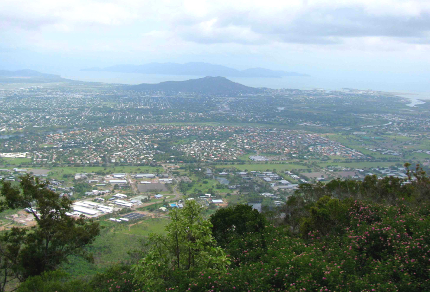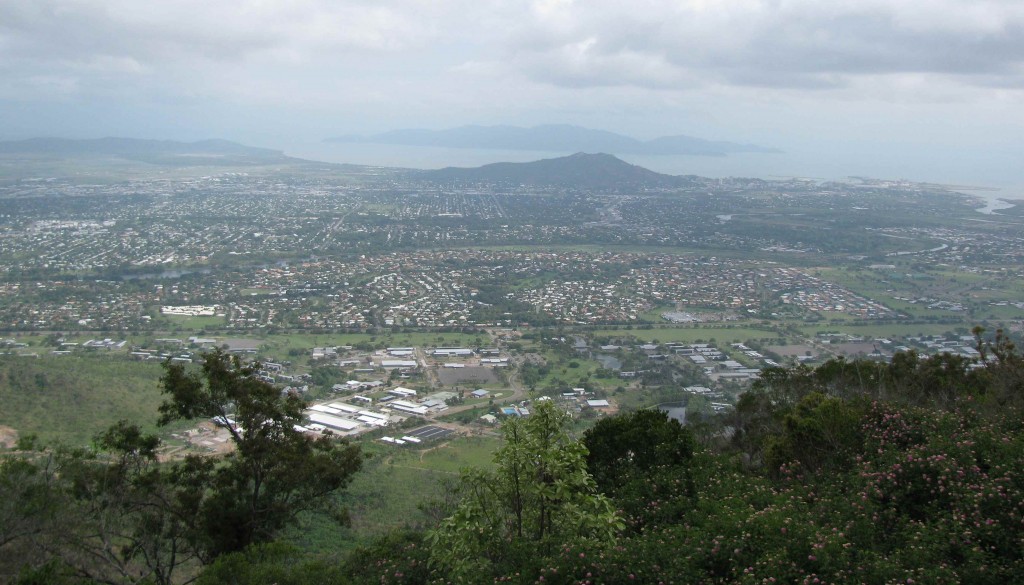
View of Townsville from Mount Stuart, with Castle Hill at centre back, and Magnetic Island beyond. Cape Pallarenda and the Many Peaks Range are to the back left. (© Vilis Nams)
In early morning, Vilis and I drove south and west from Rosslea toward Mount Stuart, the long, rugged peak rearing into the sky behind James Cook University. A black kite flew alongside us for part of the way, and from a stop on the lower slope of the mountain, we noticed that the air smelled different – cool and rich with clean plant fragrances that didn’t cloy. Less enticing were the barbed wire fences that paralleled the access road on both sides and were prominently posted with warning signs that stated DANGER, RANGE BOUNDARY, KEEP OUT UNLESS AUTHORISED, DO NOT TOUCH ANYTHING, IT MAY EXPLODE AND KILL YOU. All of Mount Stuart, with the exception of the access road leading to the summit with its communication and weather towers and small nature reserve, is a training ground for the Lavarack Army Barracks, located just down the road from JCU.
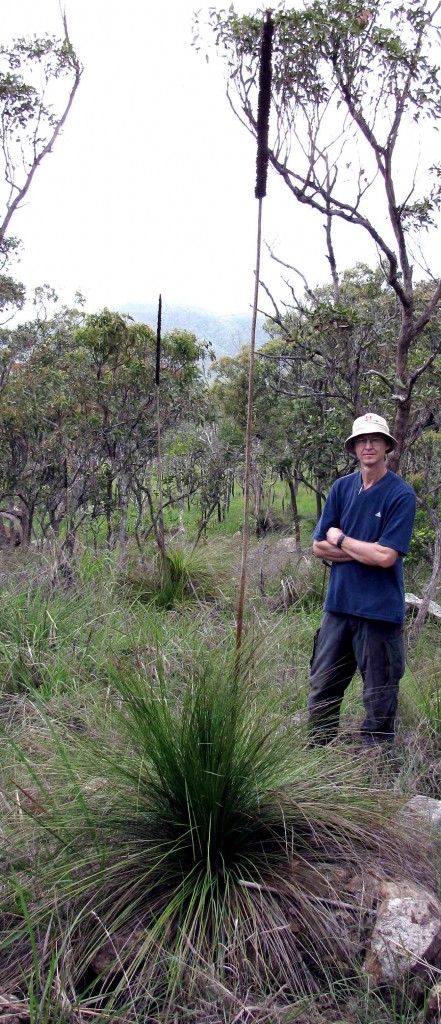
Grass-tree (© Magi Nams)
As we proceeded up the peak, burn scars were evident on trees and on scorched, twisted stumps of grassy-topped plants. Some of latter had charred flowering stalks 3 metres tall. I looked for rock wallabies, which Chris Johnson told us last night inhabit these slopes, and caught a momentary glimpse of what I thought were ears and a head. The cloudy sky was a wonderful change from bald sunlight, and the cool, upland air refreshed us after this past week’s continuous days of heat.
From the Rotary Lookout just below the 584-metre summit of Mount Stuart, we gazed out over a panoramic view of Townsville and its surroundings, locating the broad blue slash of the Ross River, the campus of JCU and the military barracks at the foot of the mountain below us. Off in the distance, we spotted Castle Hill and Magnetic Island, as well as Cape Pallarenda and the Many Peaks Range bordering the expansive wetlands of the Townsville Town Common Conservation Park. Massive pink granite boulders on the escarpment edge near our feet dropped away into apparent nothingness, their upper crevices filled with verdant mounds of pink- or orange-flowering low shrubs. These boulders and the sheer cliffs below them comprised part of that stark, broken face of the mountain I had so often seen from the river parkway.
We strolled a loop track, first among boulders and then through scrubby forest in a small nature reserve. A gold-flecked pheasant coucal perched in a clifftop tree, and a dusky honeyeater – sleek and coppery brown – dipped its long, curved, black bill into a shrub’s orange blossoms. From interpretive signs, we learned that Mount Stuart and other of the area’s peaks, including Castle Hill, are the remains of granitic intrusions. The granite formed as slow-cooling, sub-surface igneous rock, but was later exposed to the elements due to erosion of the surrounding earth’s crust.
We also learned that the stunted, wind-warped trees growing on the peak’s summit are Mount Stuart ironbarks, which are endemic to this peak and one other nearby site, growing nowhere else. The open forest we saw growing on the surrounding slopes, on the other hand, is an example of tropical savannah woodland, one of the most widespread vegetation communities in the dry tropics of Australia.
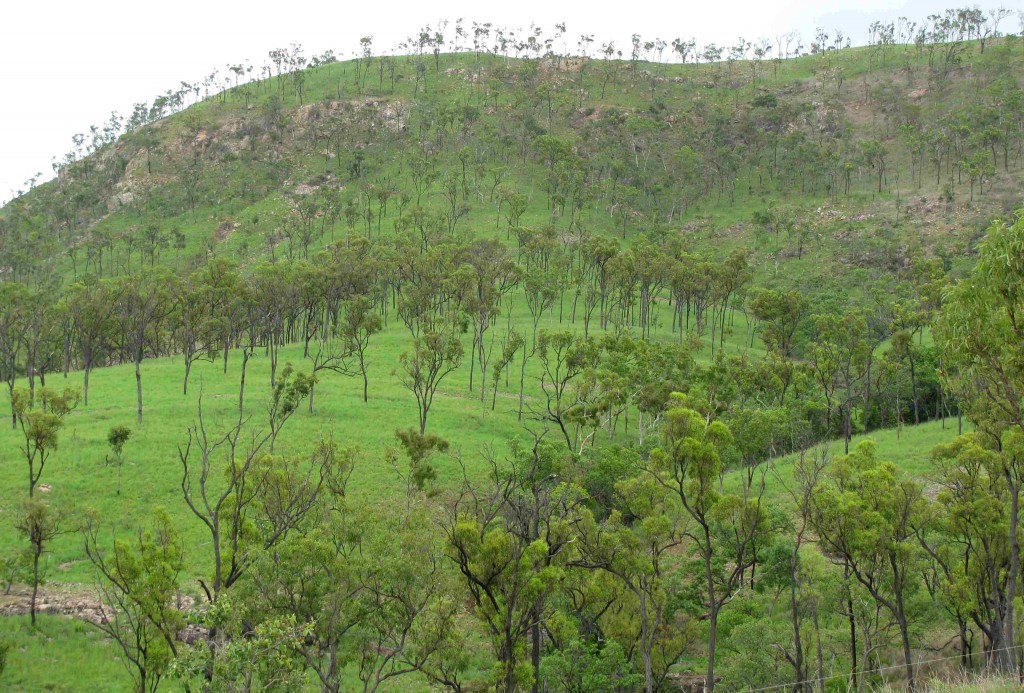
Open Savannah Woodland on Mount Stuart, Queensland (© Vilis Nams)
According to the interpretive sign, this tropical savannah woodland is one tough association of plants. It can survive extremes of wet or dry conditions, as well as bushfires. On Mount Stuart, the savannah woodland is dominated by a kangaroo grass understory and a eucalypt overstory of crooked, thin-trunked trees that include white mahogany and pink bloodwood. I found the plant names captivating, and learned that the scorched, twisted-stump plant with the grassy top and tall flowering stalk we noted on our drive up the mountain is called a grass-tree and is an Australian vegetation icon. After a fire, the grass-tree produces its towering flowering spike having thousands of tiny white blossoms.
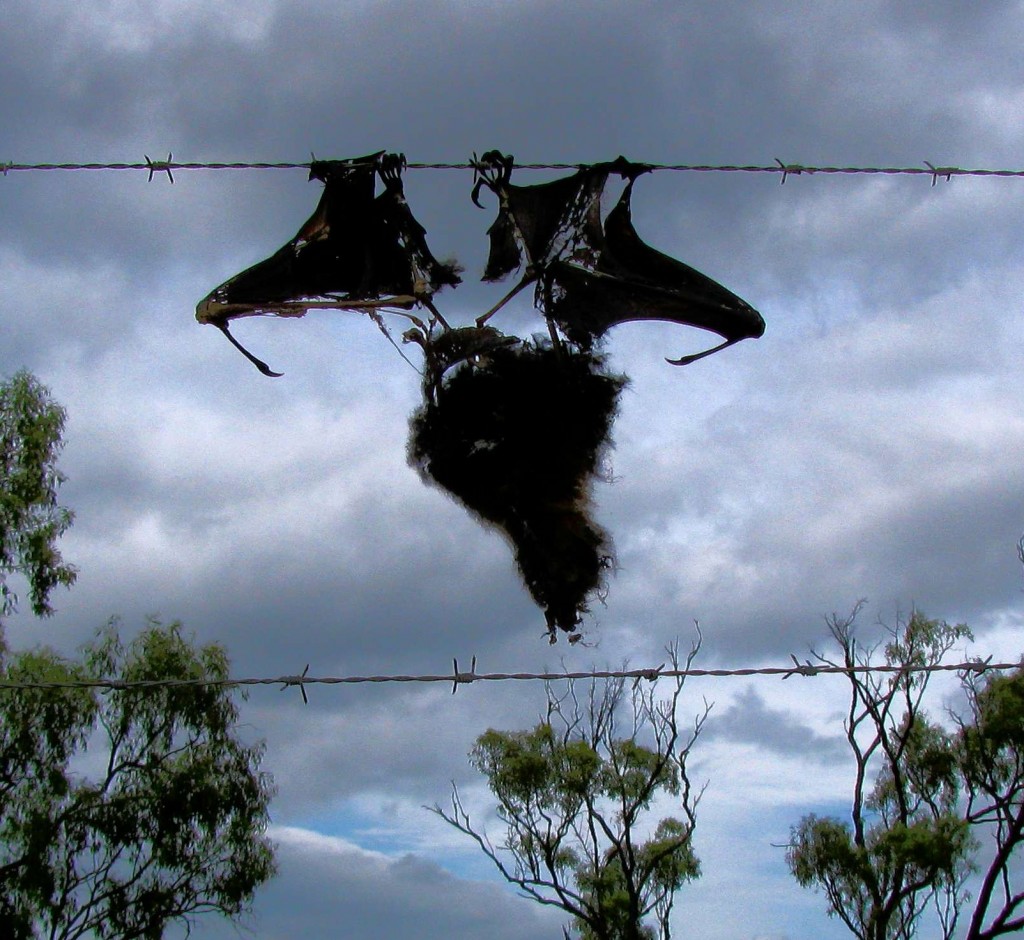
Flying Fox Remains on Barbed-wire Fence, Mount Stuart (© Vilis Nams)
During our drive down the mountain, I spotted a dark, ragged shape caught on one of the barbed wire fences. Closer inspection revealed the remains of a flying fox. The bat’s wing membranes were snagged on metal barbs, and its dead, slender toes still clung to the top fence wire.
I found the feet fascinating and thought of the incredible number of hours a flying fox’s toes support its weight while it rests. We could never do it. The fox’s secret is in the tendons of its legs, which lock when the bat grips a perch with its claws.1 In order to be able to fly, a resting flying fox must flap both wings and swing its body up until it’s almost horizontal. This relieves the weight stress on the legs, frees the tendons from their ratchet-like locking system, and allows the claws to unlock and release the perch.1 The bat caught on the fence, with its wings snagged by the barbs, would have been utterly incapable of releasing its claws’ grip on the wire and likely died of starvation.
Hours ago, I watched the return of the night fliers in the dim light before sunrise. Last evening, Chris Johnson mentioned that the blackk flying fox camp is in a mangrove swamp at the mouth of the Ross River. Based on the sheer number of bats we’ve observed making the nightly feeding forays, the camp must be a spectacular sight – and a smelly one, too. That many bats doing their business in the same place day after day has to create quite a stink. Interestingly, when flying foxes do their business, they make a switch from hanging by their toes while they’re resting, to hanging by their thumbs while they urinate or defecate, and then flip back to hanging by their toes to resume their rest.2
These flying foxes also exhibit intriguing behaviours related to rearing young. Unlike female birds that leave young in nests or burrows while they forage for food, female flying foxes carry their young with them for their first two or three weeks, with the babies clinging to their mother’s fur.3 When the young become too heavy to carry during flight and are more coordinated, the females leave them in a ‘crèche’ in the centre of the camp during the night.3 In their book Flying Foxes: Fruit and Blossom Bats of Australia, Leslie Hall and Greg Richards paint an evocative picture of the females’ leave-taking from the crèche: “Mothers often have trouble leaving young behind when they fly off to feed. Young bats will cling desperately to their mothers’ nipples with their curved milk teeth, and hang on to branches with their toe claws when their mothers try to fly away.”3
Leaving the bat’s remains, Vilis and I departed from the cool freshness of Mount Stuart and returned to the clinging humidity and cloying tropical scents of Townsville.
References:
1. Leslie Hall and Greg Richards. Flying Foxes: Fruit and Blossom Bats of Australia. 2000. University of New South Wales Press Ltd, Sydney, pp. 28-29; 2. Ibid, p. 64; 3. Ibid, p. 45.

